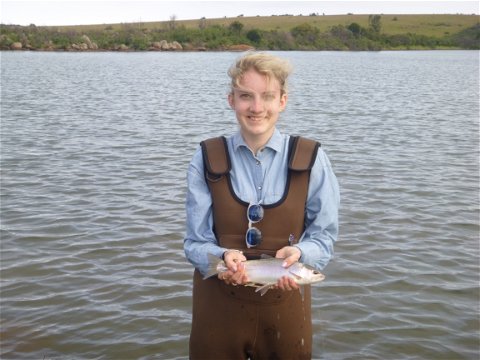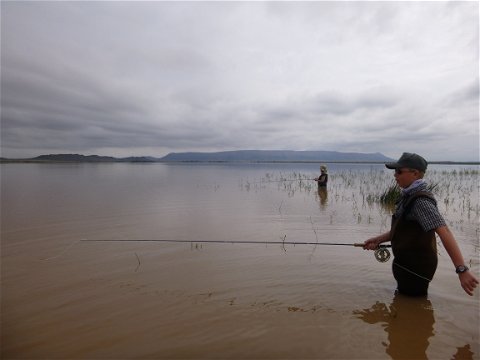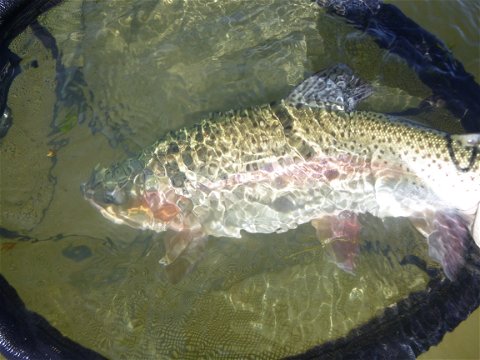With a fly rod in "Karoo"
This is an article written by one of our Danish visitors on his experience whilst fishing with Alan as a guide. It's interesting to get a foreigner's view on the things we (almost) take for granted.
What does one do when invited by ones hunting “happy” family over Easter to the Eastern Cape Province in South Africa? I could of course have started my hunting career, but instead, I packed a suitcase full of flies, reels and fly rods, from 2 – 10 weight.
While the family were sighting in their rifles on the first day, I took to the small Naudes River in a wooded valley, with fishing guide Alan Hobson. It was a few km walk from the car to the stream. Some days earlier there had been heavy rain, so the water was brown and a bit unclear.
Upstream nymphing was the best method of fishing. The fishing was primarily in some deep pools, which was interrupted by a small waterfall and ironstone. On the way up the river, I landed several small rainbow trout. I still had to get used to the help of the fishing guide, who insisted on tying both leaders and flies on for me, and to net the relatively small trout, which of course had to be photographed. I am usually expected to serve my wife and children in the same way, so I accepted that it was probably just my turn to experience a little luxury!
We ended up at the Waterfall pool, where the stream is fed by a 90m waterfall that drops down between a gorge of red sandstone cliffs. Certainly one of the most charismatic pools I have fished in my lifetime. Lunch was taken with a view to the great scenery. In between we saw the black eagle, with a wingspan of 1 ½ m, patrolling the surrounding mountains, and we heard baboons scream. After lunch we tested the pool. Alan warned me that the fish would be right against the tail of pool. I accurately presented my nymph at the edge of the pool and began to retrieve the fly a little faster than the speed of the water.
A good fish took the fly on the first cast. The fish gave a good fight with long runs and several jumps before the fish was landed in Alan’s net. An incredibly beautiful and well-conditioned rainbow of about 50cm. The fish had the finest red flanks and a golden belly – a fish which will be in memory. After a few photos the fish was released, which is fair, since Alan stocked the small trout in the pool. The fish are carried into the valley in 20 litre buckets.
After a short break I resumed fishing in the pool from scratch. After a dozen or so throws, there was another rainbow that took my nymph which my fishing guide himself had stocked. We estimated it a few centimetres shorter than the first, but it was also released. It would certainly have been possible to catch more rainbows in the pool, which had not yet been fished through, but satisfied with the day’s experiences we packed up and walked out of the valley.
Karoo
Karoo is the name of South Africa’s high altitude semi desert characterised by veldt, cacti and thorn trees. Despite the dry climate, the Karoo is full of wildlife, where you often see different monkeys, wildebeest, zebra, springboks, impala, kudu and several other antelope. Also rich in birds, including eagles, falcons, geese, ibis and the country’s national bird – the blue crane. But how can you fly fish in a semi-desert? The secret lies in the fact that there are four types of eco systems in this part of South Africa. In addition to the Karoo, there are lowlands (300 – 400 meters above sea level) with savannah, where the trees are larger. There is Grassveld on top of the mountains (1500 above sea level), in which as a consequence of greater precipitation there are lush grass meadows and trees of up to 10m. Just the opposite of the Scandinavian world! Furthermore, there are forests in some of the valleys and it is here that the fish tale began.
Fishing in the area occurs most in ponds and lakes and some streams. Generally these are located on private property, so not accessible to the public. I had previously contacted the local fishing guide Alan Hobson, who has access to a variety of waters, and he can also arrange for you to pay rod fees if you want to fish on your own. Along with his wife Annabelle, he operates the Angler and Antelope in the town of Somerset East – a bed and breakfast, where the former Catholic Church has been transformed into a dining room and whisky bar. In addition, the church has probably the world’s smallest “fly shop” located in the old confessional! I now have a small collection of blessed flies!
In addition to being a skilled fishing guide, Alan has a huge knowledge of the area’s flora and fauna, so while fishing one will hear about animal tracks, insects, spiders, butterflies, plants etc., which provides an extended dimension that will not be obtained by fishing on your own. Guided fishing is inclusive of fishing tackle, waders, etc., if you don’t bring your own gear, which, however, I would recommend.
Alan manages and stocks the waters in Somerset East. As in Patagonia and New Zealand, trout are stocked and do not occur naturally. The first trout were introduced to South Africa by the British in 1867, so there are rich traditions of fly fishing in the country. As trout do not spawn in dams and most streams, they must be stocked and catch and release is encouraged. Stocking is mostly done with rainbow trout as they are more heat tolerant than brown trout. They are stocked as fingerlings, and grown out to beautiful healthy fish. In the waters of Somerset East, they are very fast growing reaching sizes of more than 45cm in just 3 years. Every now and then big trout are caught up to 6kg. The good growth is due to the freshwater crabs, similar to our domestic shore crab. Trout eat small crabs. In addition, there are various mayflies, caddis flies, mosquitoes, etc. and dragonfly nymphs and damselfly nymphs in the water are also important food items. In Africa there are the coolest insects.
My dream is to experience fly fishing during a termite / flying ant hatch.
American largemouth bass have been introduced into some of the waters and they thrive in the warm water. Alan has access to waters with 10 lb bass who willingly grab a popper so it may need to be tested next time I come on a trip (several family hunters have developed a powerful kudu fever!)
Then there is Bass
The family’s younger children also had to be entertained, and we took turns between hunting and fishing trips. We stayed at the Danish owned Malpepo farm and the farm swimming pool helped with keeping the kids occupied. One day we did a walk in the bush and another afternoon we drove to Glen Avon Farm, where fishing is easily accessible in a few dams previously used for the milling operation. We elected to pay rod fees for the bottom dam where there were many small bass so the young people caught their first fish on fly. They were also invited to the local farmer’s sheep shearing, so it was a very eventful day. The small bass came home and we found that they had crabs in the stomach. The Danish Copper darling can now be said to be a crab imitation and bass fly. We ate bass which is an experience at the level of a perch.
Trout Bum lessons
Along for the ride was my niece Anna, 17 years old. Anna had no hunting ambitions, but wanted to try fly fishing, so she was apprenticed as “Trout Bum”. We paid rod fees for a number of smaller dams on the mountain where we had to drive up a steep mountain road in very poor condition. When we almost reached the dams we realised that we had a puncture. Lesson 1 was how to change the spare wheel, which was like a large moped wheel. Since we had already passed the worst part of the mountain road, we chose to continue up to the 5 dams which we would be fishing. There were three dams created on a small stream which was completely dry. There were dams to collect rainwater for the cattle and sheep. We trudged up to the top pond, where there are trout.
The first hour passed with a little instruction in casting and fishing technique (lesson 2), while we saw a few rises. We tried both nymphs and dry flies without success. When I saw the remains of crabs on the banks, I tied on a “bugger fly” with bold red rubber legs on the tippet. On the first cast I caught a small trout right next to the bank. Anna now had a similar woolly bugger on her line and with a little help she caught her first trout on fly (lesson 3). We got several takes and another small trout before we stopped at noon, when we went down the mountain on the small spare wheel. The day was over. I decided to have a few casts in the bottom dam. I saw a small shoal of bass which willingly followed the fly, but without any bites. This occurred several times. Then I tried to let the fly fall right down to the bottom and lifted it again, like a fleeing crab. It worked! In fifteen minutes I had another bass, so it was a little reluctantly that we packed up and drove down to the town of Somerset East to fix the tyre.
Mountain dam
A few days later we were on tour with Alan Hobson again. It started with Anna and also my oldest son Valdemar, 15 years. Valdemar had shot his allocation of both Impala and Blue Wildebeest, so now had time to fish. Today we drove further up the mountain. This dam used to be a water reservoir, and is fed cold water from several springs. We saw some crab shells lying along the bank – remnants of an otter meal. In one place a bush pig had dug a hole for a refreshing mud bath. I told Alan to use his energy to help the young people and that I could easily cope by myself. While we rigged rods, we saw fish rising along the reed edge. I considered both a crab-like fly and a nymph, but chose to put a small dry caddisfly at the tip. When the first fish took I was too slow and missed the take, but I found the timing and caught a series of beautiful and strong rainbows primarily in the range of 35 – 45 cm. The young people also caught fish. Lunch was excellent grilled Karoo lamb and other meat. After lunch we fished again, and we caught a few more good fish. We brought home a handful of fish – mainly caught by the youngsters, which was served as a delicious starter on the farm the next night.
Barbel
On the last fishing day we tried something different. We went on a trip with Alan to a large dam north of the town of Cradock. My wife and other son Kristian also came along for the ride. The dam is fed by water pumped through a tunnel from the Vaal River, which is located about 1500 km away. The lake and tunnel is a prestigious project built under the former apartheid regime, in order to supply water to white farmers in the south of the country. With the water came more species of fish that were not previously in this part of South Africa. One of these is the catfish (Sharp toothed Barbel), which was our goal. The fish can grow up to 40 kg, so out came the heavy equipment. The water in the dam was very clear with a reddish colour and the possibility of sight fishing, where the catfish feed in the reeds. The flies must be thrown hard on the surface, as catfish pick up the sounds and vibrations. In order to lure and attract additional attention from the weak sighted eyes, we added a popper head to the leader about one meter above the streamer flies. As with many other things fishing, we should have been there the day before. Overnight, the water level in the dam had risen to 2 feet above normal, so the catfish were not in the shallow water. We saw some eyes which were on the surface further out, and once there was a fish that cruised leisurely in the reeds just between Valdemar and I. On the way home we tried small stream where we fished in a pool at a railway bridge. The target was yellow fish, although it was not really seasonal and the water was green with algae. Yellow fish is a strong indigenous African fish, which is similar to a gold-coloured carp and is most often caught on dry flies and nymphs. My son Kristian had a few bumps on a small nymph, but otherwise nothing happened. Thus, without fish on land, but it was almost worse for our fishing guide than for us fishermen.
Republic of South Africa:
Easter 2015 was a memorable experience for the whole family in South Africa, where my mother (to be lucky!) had invited the husbands, daughters-in-law and grandchildren on the holiday of a lifetime. The trip went to Malpepo Safari, which is a Danish-owned farm near the town of Somerset East about 200 km north of the port city of Port Elizabeth. The farm operates hunting tourism of mainly antelope. South Africa is an exciting holiday destination. South Africa has, inter alia, a number of national parks, which are obvious excursion destinations, and when not hunting, the animals are easy to see and experience at close quarters. The country has many good accommodation and good restaurants. The exchange rate of the South African Rand is currently low so is a cheap option for the Danish visitor. It is also recommended that you hire a 4-WD as the roads in the country are extremely rigorous. South Africa is in the Southern Hemisphere and travel can be organised when Denmark is cold and dark. If trout fishing is your target, avoid the hottest summer months – December to February. There are many fishing opportunities in South Africa. In the southern provinces – West and East Cape and in Kwa Zulu Natal and in the small kingdom of Lesotho (enclave to South Africa) there is good trout fishing with many options. In the northern parts of the country there are yellow fish and catfish in the Orange-Vaal river system and in Limpopo. Sterkfontein dam has world class fishing for yellow fish. There are many places for bass fishing as well as fishing for queen fish, lady fish, etc. and fishing off shore for tuna, marlin etc. The new South Africa was created in 1993 when the country put the apartheid regime behind it, and the people elected Nelson Mandela as the republic’s first president. South Africa is multi-cultural and many languages are spoken. In the area around Somerset East, in addition to English, Xhosa (original Black Africans) and Afrikaans (a language originating from the Dutch Settlers) are spoken. You often hear about high crime in South Africa, but on our trip we experienced no unpleasant things and we felt confident in the streets, though by Danish standards you meet many poor people, primarily in the cities.
Fly patterns:
The blessed flies
The South African fishing guide Alan Hobson is a skilled and creative fly tier, and has developed a number of flies for local conditions in South Africa. The flies will certainly be able to be used for Nordic trout in rivers in lakes.





Share This Post